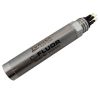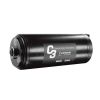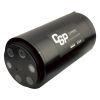Turner Designs Cyclops-7F Submersible Sensors
Features
- Interfaces easily with most data collection platforms using 0-5 VDC output
- Very low power consumption allows for extended remote deployments
- Interfaces with DataBank Handheld Data Logger and Cyclops-7 Logger
- Free ground shipping
- Expedited repair and warranty service
- Lifetime technical support
- More
Overview
The Turner Designs Cyclops-7F submersible fluorometer sensors are designed for integration into remote data collection and telemetry platforms. The sensors offer a unique combination of performance and size, making them very attractive for freshwater, coastal, and oceanographic environments. Cyclops-7F sensors are configured and factory scaled for the specific analysis of turbidity, chlorophyll, phycocyanin, phycoerythrin, rhodamine dye, fluorescein dye, CDOM, crude oil, optical brighteners, PTSA dye, or tryptophan.
Durable
The Cyclops-7F sensor features a locking sleeve Impulse connector with cable options available from 2 feet to 50 meters. The rugged stainless steel construction is designed to withstand most environmental conditions. Common applications include turbidity dredge monitoring, algal bloom notification, and dye tracer studies.
In The News
Wildfire smoke alters a lake's ecology from the top to the bottom of the food chain
Wildfires have been big news the last couple of years. Australia’s wildfires in 2019 and 2020 and the Amazon rainforest fires in 2021 made headlines around the world. The American west has had record-breaking burns in recent years, blanketing cities in dangerous amounts of smoke and sending haze across the continent to the east coast. While smoke has clear and apparent effects on the sky, new research finds it changed the ecology of Castle Lake, a freshwater lake in California, in 2018. “There are some studies that have analyzed the effect of human health in respiration with the smoke of wildfire,” said Facundo Scordo, a postdoctoral researcher at the Global Water Center of the University of Nevada—Reno.
Read MoreSave our Bogs! Culture, Conservation and Climate Action in Ireland’s Peatlands
Characterized by long-term accumulation under waterlogged conditions, peatlands exist on every continent and account for 3-4% of the global land surface . Small but mighty, these often overlooked wetland environments are estimated to hold as much as one-third of the world's organic carbon in their soil—twice the amount found in the entirety of the Earth's forest biomass. While healthy peatlands can trap and store carbon, regulate water, and provide important habitats for rare species, human alteration has disturbed peatland carbon and nitrogen cycles on a global scale. Approximately 12% of the world’s peatlands have been drained and degraded through conversion for agriculture, forestry, infrastructure development, and other uses.
Read MoreSargassum Surge: How Seaweed is Transforming our Oceans and Coastal Ecosystems
Until recently, Sargassum –a free-floating seaweed–was distributed throughout the Sargasso Sea , the north Caribbean Sea, and the Gulf of Mexico. But in the space of a decade, this seaweed has, as one scientist remarks , “Gone from a nonfactor to the source of a terrible crisis.” Driven by climate change, anomalous North Atlantic Oscillation in 2009-2010 and a glut of anthropogenic pollutants, sargassum has proliferated. Seasonally recurrent mats as deep as 7m now bloom in the “Great Atlantic Sargassum Belt” (GASB), which covers areas of the Atlantic from West Africa to the Caribbean Sea and Gulf of Mexico. Every year, millions of tons wash up along the shores of more than 30 countries . Dr.
Read More





























